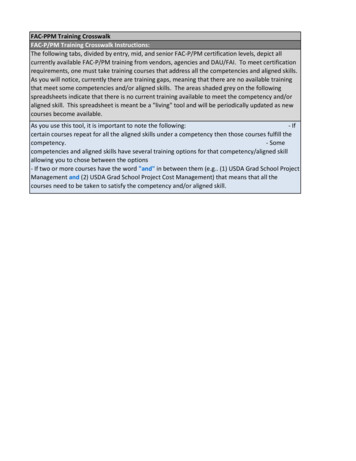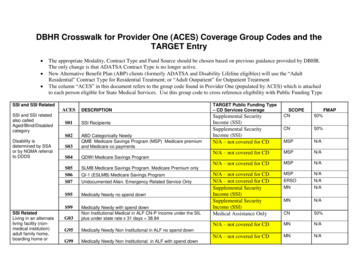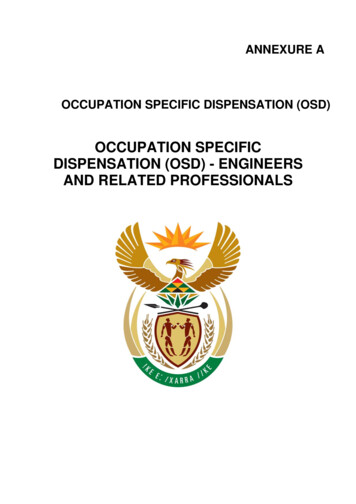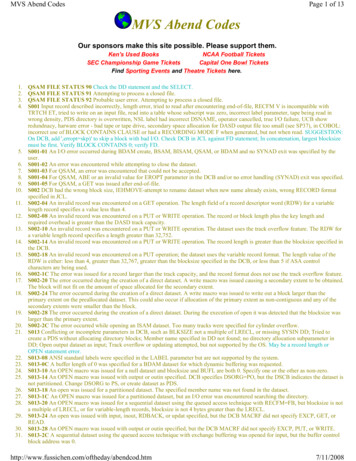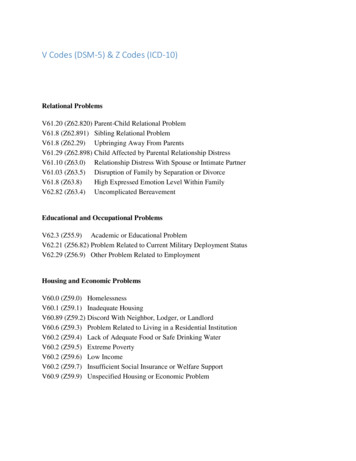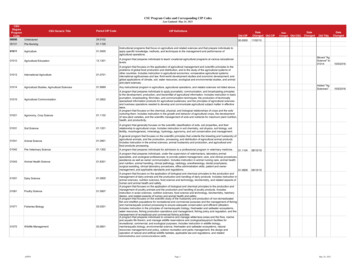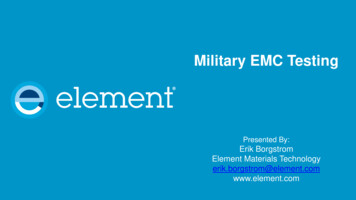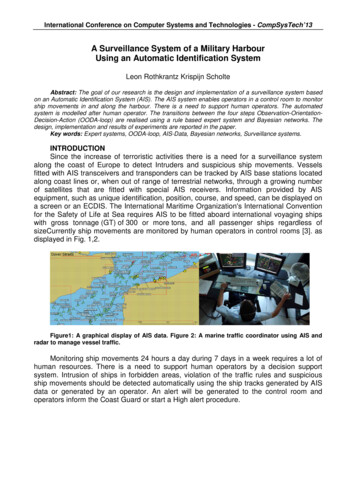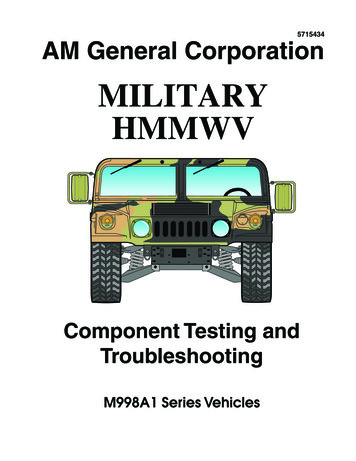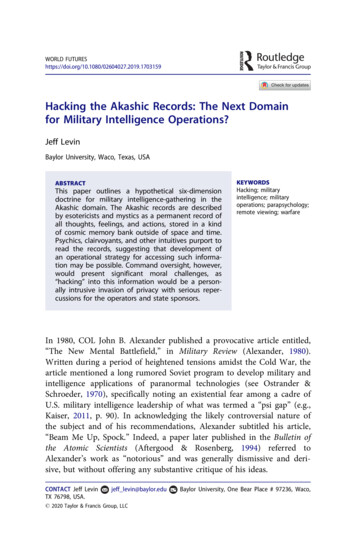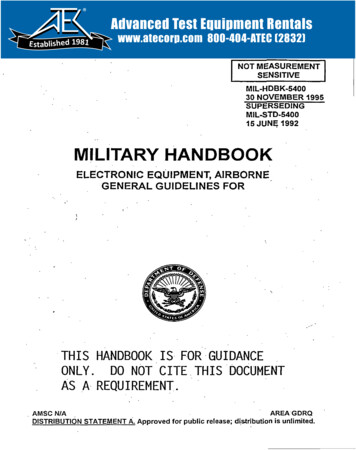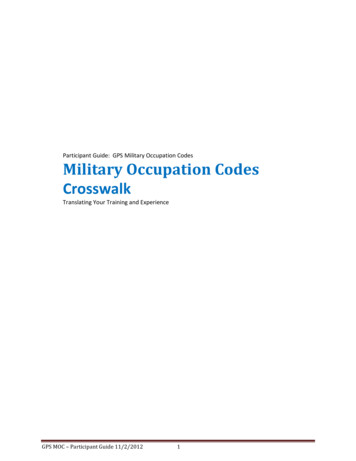
Transcription
Participant Guide: GPS Military Occupation CodesMilitary Occupation CodesCrosswalkTranslating Your Training and ExperienceGPS MOC – Participant Guide 11/2/20121
TAPS GPS Road MapK – CapstoneService members will attend Capstone whichvalidates and verifies that the service member isprepared to be successful following their militaryservice by producing documentation that they meetall Career Readiness Standards.J - Entrepreneurship TrackService members pursuing self-employment in theprivate or non-profit sector will learn about thechallenges faced by entrepreneurs, the benefits andrealities of entrepreneurship, and the steps towardbusiness ownership.I - Technical Training TrackService members pursuing further technical trainingwill receive guidance and help in selecting schoolsand technical fields.H - Education TrackService members pursuing college education willreceive guidance to prepare for the collegeapplication process. The Education track addressessuch topics as identifying one’s educational goals,education funding, and researching and comparinginstitutions.G - DOL Employment WorkshopAddress the nine key factors that contribute to asuccessful employment transition.F - VA Benefits I & IIInform transitioning Service members of theirVeterans benefits options.E - MOC CrosswalkTranslates military skills, training, and experienceinto credentialing appropriate for civilian jobsD - Financial PlanningProvide information and tools needed to identifyfinancial responsibilities, obligations, and goals afterseparation from the military.C - Join ReservesAfford Service member to continue their militaryservice in a Reserve Component.B - E-Benefits RegistrationProvide Service members, Veterans, and theirfamily’s access to benefits, information, otherservices, and support.A - Pre-Separation Counseling and AssessmentIntroduce Service Member to full range of programsand services.GPS MOC – Participant Guide 11/2/20122
Table of ContentsTABLE OF CONTENTS . 3PREFACE . 4MILITARY OCCUPATION CODES (MOC) CROSSWALK . 5MODULE PRE-REQUISITE (PLEASE HAVE WITH YOU): .5MODULE PURPOSE:.5OUTCOME: .5COMPETENCIES: .5MILITARY OCCUPATIONAL CODE CROSSWALK . 6CROSSWALK . 7TYPES OF JOB SEEKERS . 8TOOLS FOR TRANSITION (CON’T) . 9TOOLS FOR TRANSITION (CON’T) . 10TOOLS FOR TRANSITION (CON’T) . 11CREDENTIALING . 12CREDENTIALS . 13THE IMPORTANCE OF CREDENTIALING . 14INFLUENCES ON CAREER SELECTION . 15INFLUENCES ON CAREER SELECTION - CONTINUED . 16O*NET MY NEXT MOVE ---INTEREST PROFILER . 17O*NET AND MYNEXTMOVE INSTRUCTIONS . 18O*NET – MY NEXT MOVE FOR VETERANS . 20PERSONALIZED TAP GPS GAP ANALYSIS . 21SUMMARY . 25APPENDIX A—ADDITIONAL PROGRAM RESOURCES . 25VETSUCCESS.GOV . 27VETSUCCESS.GOV FEATURES . 28VA FOR VETS . 29HERO2HIRED . 30HERO2HIRED FEATURES . 31CREDENTIALING OPPORTUNITIES ON-LINE (COOL) WEBSITES . 32GPS MOC – Participant Guide 11/2/20123
PrefaceThe purpose of this module is to begin the process of identifying skills, experience, credentials,and education that have been obtained while in the military and crosswalking them to civilianopportunities.You will learn about the different types of job seekers and how to conduct a Military OccupationCode (MOC) crosswalk. You will participate in an activity to crosswalk your individual MOC tocivilian career opportunities identifying the gaps needed to be explored in order to be moreemployable and marketable in the civilian sector.GPS MOC – Participant Guide 11/2/2012Page 4
Military Occupation Codes (MOC) CrosswalkModule Pre-requisite (Please have with you): Verification of Military Experience and Training (VMET) documentation Transcripts (SMARTS/AARTS/CCAF) Servicemember’s performance reports / training records Individual Transition Plan (ITP) documentationModule Purpose: By the end of this training, you will develop a MOC gap analysis that will help you identify theskills you have, compared with the skills you need, to obtain the civilian career you desire.Outcome: To complete an initial Gap Analysis ActivityCompetencies:1. Identify civilian jobs that are relevant to personal career goals2. Identify skills sets required for civilian jobs3. Research of personally selected geographic locations and demand occupations according toemployment outlook/labor market informationLearning Objectives: Review and interpret the Verification of Military Experience and Training (VMET) transcripts tocivilianize military terminology Identify needed credentials/education and balance with Sailor and Marine American Council onEducation Registry Transcript, Army ACE Registry Transcript, and Community College of the AirForce (SMART/AART/CCAF) recommended credit Identify gaps between current knowledge, skills, and education/training as they relate to civilianoccupational requirements Identify primary and alternative occupational goals based on labor market information (LMI) andindividual qualifications Identify and research career employment opportunities of interest Update Individual Transition Plan (ITP) informationGPS MOC – Participant Guide 11/2/2012Page 5
Military Occupational Code CrosswalkMOC Crosswalk IntroductionThe purpose of drafting a crosswalk of your MOC is to identify and relate civilian career opportunitiesand requirements to your current military education, training, and experience. The MOC crosswalk helpsyou identify your skills, experience, and abilities.Some Servicemembers know that they want to pursue education, a certain career, going into businessfor themselves, working part-time, or entering a technical field; while others are undecided and coulduse more exploration and assistance in their career search.Veterans currently have a much higher unemployment rate than their civilian counterparts. The goalbehind the MOC crosswalk is to increase your employability and to provide you with the greatestopportunity for success.Military experience, values, and ethics (technical skills, dependability, trainability, commitment,dedication, and teamwork) are valued and highly desired by the civilian sector. You have many skills andexperiences to offer employers.The challenge you will face as a Veteran will be to communicate these acquired skills and experiencesinto marketable civilian traits. This module is intended to make your transition easier, faster, and moreproductive and will help you determine goals to set, a path to take, and the steps to complete yourtransition.GPS MOC – Participant Guide 11/2/2012Page 6
CrosswalkMOC Crosswalk ProcessTranslating your education, training, experience, and skills into civilian career goals and jobs is a multistep process that can have a variety of outcomes.This process is as follows:1. Examine your military experience and training records2. Identify civilian occupations that correlate to your experience, abilities, and goals3. Identify civilian careers that align with your experience and desires4. Identify the education, experience and credentials required5. Explore the labor market in the geographic area where you are interested in living6. Re-evaluate goals based on steps 2-57. Document the gap between what you want to do with civilian occupations and skills in demandin the area to which you are relocatingGPS MOC – Participant Guide 11/2/2012Page 7
Types of Job SeekersInitially, it’s important to understand the different types of job seekers and where you fit. The types ofcareer exploration techniques you use can and should be tailored for your specific circumstances. Ofthe categories listed, which one best describes you and your situation?Transitioning Specialist – A Servicemember who has held a technical military occupation and wants tocontinue in that occupational area in the civilian workforce. Example: an Air Traffic controller in themilitary who wants to continue as one in the civilian workforce.Transitioning Generalist – A Servicemember who wants to exploit the general and leadership skillsacquired through military service in the civilian workforce. Example: a senior NCO withinstructional/training background who wants a position as a corporate trainer.Career Switcher – A Servicemember who wants to pursue a specific civilian occupation that is unrelatedto military occupation or experiences. Example: an electronics technician who wants to become ahistory teacher.Undecided – A Servicemember who has not decided on a specific career path within the civilianworkforce. Example: a Service member who wants to settle in a specific geographic location without aclear career path.Multi-Tracker – A Servicemember who wants to pursue a combination of civilian opportunities whichmay include employment, education, technical training, entrepreneurship, or volunteerism. Example: amedical corpsman who is attending college to become a registered nurse while concurrently employedpart-time as an emergency medical technician.GPS MOC – Participant Guide 11/2/2012Page 8
Tools for Transition (CON’T)VERIFICATION OF MILITARY EXPERIENCE AND TRAINING (VMET)The VMET document is an "all-services" integrated form which displays demographic, training, andexperience information that is retrieved from various automated sources.The purpose of the VMET report is to provide descriptive summaries of military work experience,training history, and language proficiencies. Additionally, the VMET includes recommended collegecredits associated with an individual’s military experience and training, as assigned by the AmericanCouncil on Education (ACE); and related civilian equivalent job titles, when such information is available.VMET is designed to provide successfully completed formal military training history and work experiencedating back to FY1985 (or earlier, when available).Data includes: Military occupations, titles, and pertinent dates Occupation description Additional skill codes with title and description Training course title, date of completion, length and description Any associated ACE recommended credits Any off duty education and foreign language proficiencies, as provided by your Branch ofServiceNOTE: Documents are requested and delivered thru the VMET web site:https://www.dmdc.osd.mil/vmet/owa/vmet web display.loginGPS MOC – Participant Guide 11/2/2012Page 9
Tools for Transition (CON’T)For crosswalk purposes, you should focus within the following areas: All titled “occupation” codes “Occupation description from service file” information “Related civilian occupation” for related civilian occupation titles “Course description from American Council on Education” for consideration in any additionaleducational and certification requirements indentified for career exploration “Additional qualification(s)” for review of additional skills sets you may have acquiredThe first step in identifying related civilian occupations is to verify the knowledge, skills and abilities(KSAs) that can be used for resume building and verification of experience to an employer.GPS MOC – Participant Guide 11/2/2012Page 10
Tools for Transition (CON’T)SERVICE TRANSCRIPTSService transcripts are education/training transcripts (SMART/AART/CCAF) obtained online or throughthe base education office. They may be ordered and evaluated by the Servicemember and may apply toevery Servicemember (enlisted, officer, and warrant officer). Transcripts downloaded by theServicemember are considered unofficial. Sailor and Marine American Council on Education Registry Transcript (SMART)o Identifies upper and lower level credit recommendationso Identifies course hours and descriptionso Identifies military experience related to college creditArmy American Council on Education Registry Transcript (AART)o Identifies upper and lower level credit recommendationso Identifies course hours and descriptionso Identifies military experience related to college creditCommunity College of the Air Force (CCAF)o Identifies course hours and descriptionso Identifies military experience related to college creditThese resources may overlap with Verification of Military Experience and Training (VMET).The transcripts provide all education courses and training – even when not in the “line of duty”. Thetranscripts identify competencies and strengths and how they might apply to various civil career paths.The transcripts assist with: Identifying skills to help guide you to a career field Reinforcing career path/continuing education Composing your resume Determining your education path – you could pursue further education, or use what you have topursue more education or a “degree” programAdditionally, transcripts recommend college credit for prior experience and learning. You can use theserecommendations to advocate for college credit at a learning institution.When colleges accept your recommended credit hours, time spent in your education process will beexpedited saving you tuition dollars and time in school.For example, 1 semester hour of college credit is recommended for 15 classroom hours through CCAF.GPS MOC – Participant Guide 11/2/2012Page 11
CredentialingIntroduction to CredentialingSome occupations have certain professional and technical standards required to perform that job. Theprocess of meeting these standards and earning official recognition of credentials– licenses,certifications, or apprenticeships – is called credentialing. Private and government organizations –generally called credentialing boards – set credentialing standards. Some credentials have educationalrequirements as part of eligibility.Credentials supply documented proof of your ability to perform in a certifiable career field. They helpdevelop a more diversely skilled workforce, broaden professional development, and validateprofessional knowledge and skills gained through experience, technical education and training.Sometimes when doing a crosswalk, multiple credentials are shown. There can be 20-30 relatedcredentials to specific occupations. You will need to do research for the specific occupation and look atjob listings to determine specific requirements.Many military specialties require certification or licensure to perform the same job in thecivilian world.Check with specific state or professional organizations for certification and licensurerequirements. Federal, state, or local laws may require specific credentials to perform theduties in some occupations.If you have credentials in occupations you do not wish to pursue, they can still be veryimportant in a related career, so don’t discount their usefulness until you conduct thoroughresearch.GPS MOC – Participant Guide 11/2/2012Page 12
CredentialsThree Main Types of Credentials1. Licensure – Governmental agencies—federal, state, or local—grant licenses to individuals topractice a specific occupation, such as a medical license for doctors. State or federal laws orregulations define the standards that individuals must meet to become licensed. Licenses aretypically mandatory.2. Certification – Non-governmental agencies, associations, and even private sector companiesmay grant certifications to individuals who meet predetermined qualifications. Thesequalifications are generally set by professional associations (for example, National Commissionfor Certification of Crane Operators) or by industry and product-related organizations (forexample, Novell Certified Engineer). Certification is typically an optional credential; althoughsome state licensure boards and some employers may require certification. For manyoccupations, more than one organization may offer certifications.3. Apprenticeship – A registered apprenticeship program is an industry-based approach to trainingthat combines paid on-the-job learning with job related education. It is a written plan to movean employed apprentice from low or no skill level to the full performance level foroccupationally identified skill sets. A registered apprenticeship program must meet programparameters established under the National Apprenticeship Act. The Act and its promulgatingregulations are administered by the U.S. Department of Labor’s Office of Apprenticeship or aSecretary of Labor approved State Apprenticeship Agency. (See Appendix A for moreinformation)GPS MOC – Participant Guide 11/2/2012Page 13
The Importance of CredentialingWhy Is Credentialing Important May be required by law or by an employer for entry into employmentMay lead to higher pay or improved prospects for promotionDemonstrates to civilian employers that training and skills attained in the military are on parwith those gained through traditional civilian pathwaysDeciding Whether to Pursue a CredentialLicenses are typically mandatory, so if the civilian c
o Identifies course hours and descriptions o Identifies military experience related to college credit Community College of the Air Force (CCAF) o Identifies course hours and descriptions o Identifies military experience related to college credit These resources may overlap with
